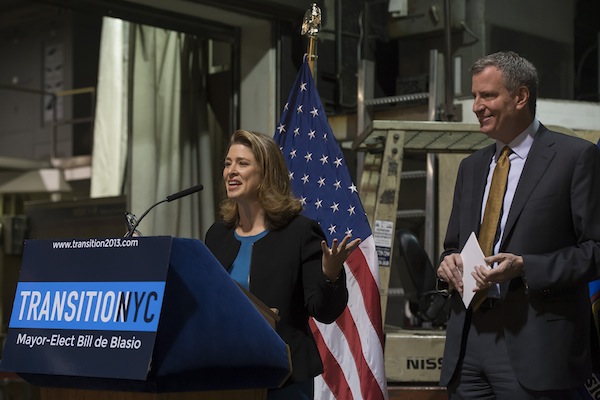
Photo by: Transition 2013
Deputy Mayor Glen and Mayor de Blasio.
The Department of Housing Preservation and Development submitted the following response to Kerim Odekon’s February 6 op-ed, “Pricey Building Raises Questions for De Blasio Housing Plan”:
Mr. Odekon’s interpretation of the development of the Bradford (aka, the Acacia, 1560 Fulton Street), an affordable housing project in Bedford Stuyvesant is based on an incorrect understanding of the Inclusionary Housing program’s zoning resolution and the combined financing structure of two affordable housing projects.
The real headline should be: City’s Inclusionary Program Makes the Most of Affordable Housing Development: Brings Opportunity to Bed-Stuy. Two new mixed-income buildings would not exist but for the Inclusionary Housing program; and the program worked to the benefit of the community by allowing the developers to maximize the total number of affordable apartments that could be built at both properties.
While opinions may differ on the approach to take full advantage of programs created to spur affordable housing and the worth of the public benefit, it is deceptive to focus on one building. Mr. Odekon focuses on the Bradford, without acknowledging the critical relationship it shares with the Garvey, a permanently affordable housing project on the same block.
The Bradford and the Garvey are two mixed-income, mixed use projects that were financed and constructed under one master development plan. In the Garvey, which was built according to the Inclusionary program, all of the 78 apartments are permanently affordable to low-income New Yorkers, with rents at $494 to $782 per month for one-bedroom apartments and $597 to $943 for two-bedroom apartments.
Under the Inclusionary program, the additional floor area is the incentive provided to the developer in exchange for designating a minimum of 20 percent of the apartments in a building as permanently affordable to low-income households. This bonus can be used on-site to build a larger project, and/or it can be used off-site at a different property within a defined geographic area.
With the all of the Garvey’s apartments being low-income and permanently affordable, it more than met the Inclusionary program’s minimum requirement and was appropriately awarded additional floor area. The additional floor area was applied to add still more affordable apartments to the Garvey, and some of what remained was used at the Bradford, resulting in more affordable units in that building as well.
The Bradford did benefit from the Inclusionary Housing program, but the suggestion that there was some requirement for it to count or create additional new permanently affordable units in order to use that extra floor area from the Garvey is plain wrong. In fact, the Bradford capped rents and income limits on the units that could have been rented to anyone at market rates.
Mr. Odekon also asks, “affordable housing for whom,” and seems offended by The Bradford’s mixed-income model because it offers some moderate-income apartments in a low-income neighborhood. He supports a practice that would have only low-income apartments created in low-income neighborhoods.
As he puts it, some people “already have options in central Brooklyn,” with the implication that families of certain incomes should have housing choices that are limited to certain neighborhoods – and without acknowledging the limited supply of affordable, rent stabilized, new construction development in many neighborhoods.
If Mr. Odekon’s theory is put into practice, it would have the effect of segregating families based on income, reversing decades of good housing policy that seeks to create mixed-income, more diverse and balanced neighborhoods.
It is also disconcerting that he also unfortunately fails to acknowledge the positive economic impacts, employment creation, and general importance to the community that mixed-income, mixed-use developments with ground floor commercial space such as the Bradford provide. Moreover, both of these developments were advanced in the depths of the recession (Garvey 2009; Bradford 2010), when most private sector real estate development was at a standstill.
Mischaracterizing the positive impact of these developments and the process by which they were created, and using that to question Deputy Mayor Glen’s track record, allegiances and commitment to the Administration’s housing agenda is misleading and divisive.
When it comes to addressing the diverse housing needs of our neighborhoods, we need to continue to work together to make New York more affordable.
Kerim Odekon responds: Mr. Enderlin claims that my concerns about affordability in the Bradford amount to support of segregation by income. Arguing that a building constructed predominantly on free public land, using tens of millions of dollars in City subsidies, should reflect the needs of Bedford Stuyvesant’s diverse residents is the opposite of a call for segregation; in fact, it is a rallying cry for inclusion. The higher-rent units in the Bradford (comprising 83 out of 105 total apartments) were subsidized in part through the City’s “New HOP Middle Income Program”, yet the minimum income required to apply to the cheapest of the Bradford’s “middle income” two bedroom units is 60 percent higher than the median (the middle) household income for New York City. Having high-rent apartments in an affordable building is good public policy, yet they should not compromise 80 percent of all units. This is not inclusive community development. The affordable housing crisis in New York City is not about a lack of $2,000/month one bedroom apartments in Bedford Stuyvesant – these apartments already exist in the neighborhood. Read more here.








